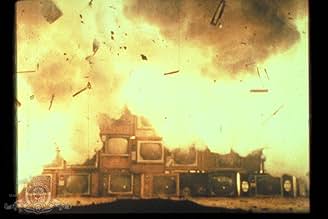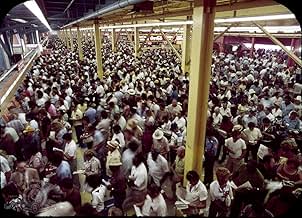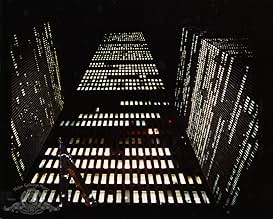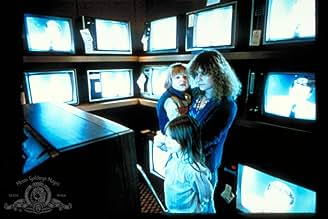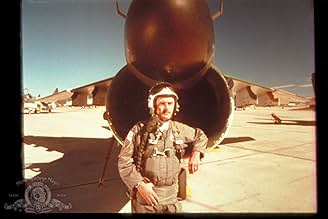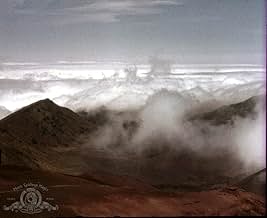VALUTAZIONE IMDb
8,2/10
43.433
LA TUA VALUTAZIONE
Una raccolta di fenomeni fotografati sapientemente. Filmati che si concentrano sulla natura, l'umanità e il rapporto tra loro.Una raccolta di fenomeni fotografati sapientemente. Filmati che si concentrano sulla natura, l'umanità e il rapporto tra loro.Una raccolta di fenomeni fotografati sapientemente. Filmati che si concentrano sulla natura, l'umanità e il rapporto tra loro.
- Regia
- Sceneggiatura
- Star
- Premi
- 6 vittorie e 1 candidatura in totale
Edward Asner
- Self - On TV
- (filmato d'archivio)
- (non citato nei titoli originali)
Pat Benatar
- Self
- (filmato d'archivio)
- (non citato nei titoli originali)
Jerry Brown
- Self - On TV
- (filmato d'archivio)
- (non citato nei titoli originali)
Johnny Carson
- Self - On TV
- (filmato d'archivio)
- (non citato nei titoli originali)
Dick Cavett
- Self - On TV
- (filmato d'archivio)
- (non citato nei titoli originali)
Marilyn Chambers
- Self - On TV
- (filmato d'archivio)
- (non citato nei titoli originali)
Sammy Davis Jr.
- Self - On TV
- (filmato d'archivio)
- (non citato nei titoli originali)
Lou Dobbs
- Self - On TV
- (filmato d'archivio)
- (non citato nei titoli originali)
Thomas Dolby
- Self - On TV
- (filmato d'archivio)
- (non citato nei titoli originali)
Linda Ellerbee
- Self - On TV
- (filmato d'archivio)
- (non citato nei titoli originali)
Jerry Falwell
- Self - On TV
- (filmato d'archivio)
- (non citato nei titoli originali)
Mark J. Goodman
- Self - On TV
- (filmato d'archivio)
- (non citato nei titoli originali)
Ted Koppel
- Self - On TV
- (filmato d'archivio)
- (non citato nei titoli originali)
Peter Sellers
- Self - On TV
- (filmato d'archivio)
- (non citato nei titoli originali)
Bill Tush
- Self - On TV
- (filmato d'archivio)
- (non citato nei titoli originali)
Recensioni in evidenza
KOYAANISQATSI remains a profound statement over twenty years after its original release. the point then is the point now.
one of the great things about this film is that while the intrusion of man is initially presented as profane and abhorrent, ultimately there is found a symmetry to the human experience that is as organic as anything found in the `natural' world. i used to be tempted to perceive humans as the only species on the plant that didn't fit, that threw everything out of balance, as it were. but over time it has become apparent that even the blight of man on earth is a naturally occurring phenomenon. the evolution of life is the destruction of life. the circle is unbroken.
one of the great things about this film is that while the intrusion of man is initially presented as profane and abhorrent, ultimately there is found a symmetry to the human experience that is as organic as anything found in the `natural' world. i used to be tempted to perceive humans as the only species on the plant that didn't fit, that threw everything out of balance, as it were. but over time it has become apparent that even the blight of man on earth is a naturally occurring phenomenon. the evolution of life is the destruction of life. the circle is unbroken.
A welcome assault on the senses, 'Koyaanisqatsi' is not for the impatient or nervous. You have to give it time because it is slightly dull in the very beginning, as the music and landscapes are fairly ordinary. Once it gets going, its really fascinating. Some gorgeous images, none generated by a computer I might add, and a soundtrack to match the intensity makes this a unique movie experience. I saw it on the big screen when it was first released, and it was MUCH better than on my not-that-big television.
One of the things I also like about this movie is the fact that since there is no dialogue, it can be shown in any country in the world unchanged. We would all see it the exact same way. I like the idea of that very much.
One of the things I also like about this movie is the fact that since there is no dialogue, it can be shown in any country in the world unchanged. We would all see it the exact same way. I like the idea of that very much.
A very beautiful flow of clips, even though some of them should frighten more than intrigue.The tempo is also part of what makes is so captivating. The clips slowly builds up and creates an alarming story. At the same time every sequence stands on its own. The lack of words gives it an almost alien view of earth and man's relationship to the planet. Together with the score by Philip Glass it sucked me in and I have rarely been so focused on every frame throughout an entire movie. It must have been quite amazing to see this in a movie theater back in the 80's with the big screen, speakers and also i guess in a time when similar creations were more scarce than now. It's by far the most visual movie I have seen and the fact that it only relies on images and music to tell a story made it bypass my rational filters and made me fully present in the moment for 86 minutes straight.
10jotix100
Godfrey Reggio's magnificent documentary "Koyaanitsqatsi" was an amazing experience when it first came out more than twenty years ago. Watching for a second time, this time in DVD format, one realizes how this movie makes the case that it must be seen in the big screen in order to get all the brilliant cinematography in its proper perspective. Even watching it in a 32 plasma screen, one realizes it pales in comparison when projected on a larger movie theater screen.
The images that are presented in the film are just beyond belief. The fantastic music score by that genius, Phillip Glass, compliments and enhances our experience. This film will live forever in spite of some of the comments submitted to this forum, because it deals with universal themes that will stay with us on this planet while human life will exist. This was pioneer movie making that later on became main stream. The originality being in the way the director presents the different sections in the film with some unusual photography that, while imitated, remains the standard for comparison with any new so called latest technique and innovation.
Kudos to Mr. Reggio, Mr. Glass and the people behind this gorgeous film.
The images that are presented in the film are just beyond belief. The fantastic music score by that genius, Phillip Glass, compliments and enhances our experience. This film will live forever in spite of some of the comments submitted to this forum, because it deals with universal themes that will stay with us on this planet while human life will exist. This was pioneer movie making that later on became main stream. The originality being in the way the director presents the different sections in the film with some unusual photography that, while imitated, remains the standard for comparison with any new so called latest technique and innovation.
Kudos to Mr. Reggio, Mr. Glass and the people behind this gorgeous film.
I first went to see this film almost by accident. Some friends were going, & it happened that Philip Glass was due to be in the cinema for an after-screening interview. I wasn't a huge fan of Philip Glass, I'd never heard of Koyaanisqatsi or Godfrey Reggio: but what the hell, I went along, expecting some sort of nicely-filmed but vaguely-boring worthy documentary.
An hour & a half later, I was - and I'm having to try very hard to find adjectives here - in fact I'm failing. It was The-Thing-That-You-Can't-Even-Tell-Someone-What-It-Is. Completely transfixed, transported, for 90 minutes of my life.
This film has no dialogue. It has no actors, apart from everyone & everything that Ron Fricke's camera touches. It has no plot, apart from just the simple, complex, unfolding story of the world.
The truth is, of all the films that people feel have really made an impact on their lives - and you only need to read through this lengthy thread to see how many of those people there are - this is one of the hardest to communicate to someone who hasn't actually seen it. You can compare it, perhaps, to things they might have seen - but there aren't that many to compare to. It has a kind of poetry on a whole different level from, for example, Man with a Movie Camera. The only things that spring to mind for me are Orphee or Last Year at Marienbad, but these are completely different kinds of movie, and even people who don't like them might be totally taken apart by Koyaanisqatsi.
Sure you could - rightly - use phrases like "breathtaking cinematography" or "unforgettable images". You could praise the music (which really opened my ears to Philip Glass). You could point out, as many have done, how the film made you look again at the world, & at your own place in it. Or you could try to relay its "environmental" message - and there are people, especially those who take any implied criticism of our species' waste and cruelty as a kind of personal insult, who will not like that message.
But none of these things would come close to capturing what makes this film so special. Like trying to explain "red" to someone who's never seen colours. You have to experience it. If possible in a cinema, sitting right down at the front, completely immersed in the screen and its images.
I know I'll never forget the first time I saw it. You might not either.
An hour & a half later, I was - and I'm having to try very hard to find adjectives here - in fact I'm failing. It was The-Thing-That-You-Can't-Even-Tell-Someone-What-It-Is. Completely transfixed, transported, for 90 minutes of my life.
This film has no dialogue. It has no actors, apart from everyone & everything that Ron Fricke's camera touches. It has no plot, apart from just the simple, complex, unfolding story of the world.
The truth is, of all the films that people feel have really made an impact on their lives - and you only need to read through this lengthy thread to see how many of those people there are - this is one of the hardest to communicate to someone who hasn't actually seen it. You can compare it, perhaps, to things they might have seen - but there aren't that many to compare to. It has a kind of poetry on a whole different level from, for example, Man with a Movie Camera. The only things that spring to mind for me are Orphee or Last Year at Marienbad, but these are completely different kinds of movie, and even people who don't like them might be totally taken apart by Koyaanisqatsi.
Sure you could - rightly - use phrases like "breathtaking cinematography" or "unforgettable images". You could praise the music (which really opened my ears to Philip Glass). You could point out, as many have done, how the film made you look again at the world, & at your own place in it. Or you could try to relay its "environmental" message - and there are people, especially those who take any implied criticism of our species' waste and cruelty as a kind of personal insult, who will not like that message.
But none of these things would come close to capturing what makes this film so special. Like trying to explain "red" to someone who's never seen colours. You have to experience it. If possible in a cinema, sitting right down at the front, completely immersed in the screen and its images.
I know I'll never forget the first time I saw it. You might not either.
Lo sapevi?
- QuizGodfrey Reggio was hooked on Philip Glass doing the music. He approached Glass through a mutual friend, and Glass replied, "I don't do film music." Reggio persisted, and finally the friend told Glass that the tenacious guy was not going to go away without at least an audience. Glass relented, though he still insisted he wasn't doing the music. Reggio put together a photo montage with Glass' music as the soundtrack, which he presented to Glass at a private screening in New York. Immediately following the screening, Glass agreed to score the film.
- BlooperThe two explosions at about 18 minutes into the film were shot with anamorphic lenses and not properly desqueezed for the film's 1.85:1 aspect ratio.
- Citazioni
[last lines]
title card: Translation of the Hopi Prophecies sung in the film: "If we dig precious things from the land, we will invite disaster." - "Near the Day of Purification, there will be cobwebs spun back and forth in the sky." - "A container of ashes might one day be thrown from the sky, which could burn the land and boil the oceans."
- Curiosità sui creditiEnd credits go over mashed voice recordings in English ranging from call operator answers to television news.
- ConnessioniEdited into Wide Awake (2006)
I più visti
Accedi per valutare e creare un elenco di titoli salvati per ottenere consigli personalizzati
Dettagli
- Data di uscita
- Paese di origine
- Sito ufficiale
- Lingue
- Celebre anche come
- Koyaanisqatsi: Life Out of Balance
- Luoghi delle riprese
- San Onofre Nuclear Generating Station, San Diego County, California, Stati Uniti(as seen from San Onofre State Beach)
- Aziende produttrici
- Vedi altri crediti dell’azienda su IMDbPro
Botteghino
- Lordo Stati Uniti e Canada
- 1.723.872 USD
- Lordo in tutto il mondo
- 1.728.699 USD
Contribuisci a questa pagina
Suggerisci una modifica o aggiungi i contenuti mancanti

Divario superiore
By what name was Koyaanisqatsi (1982) officially released in India in Hindi?
Rispondi

